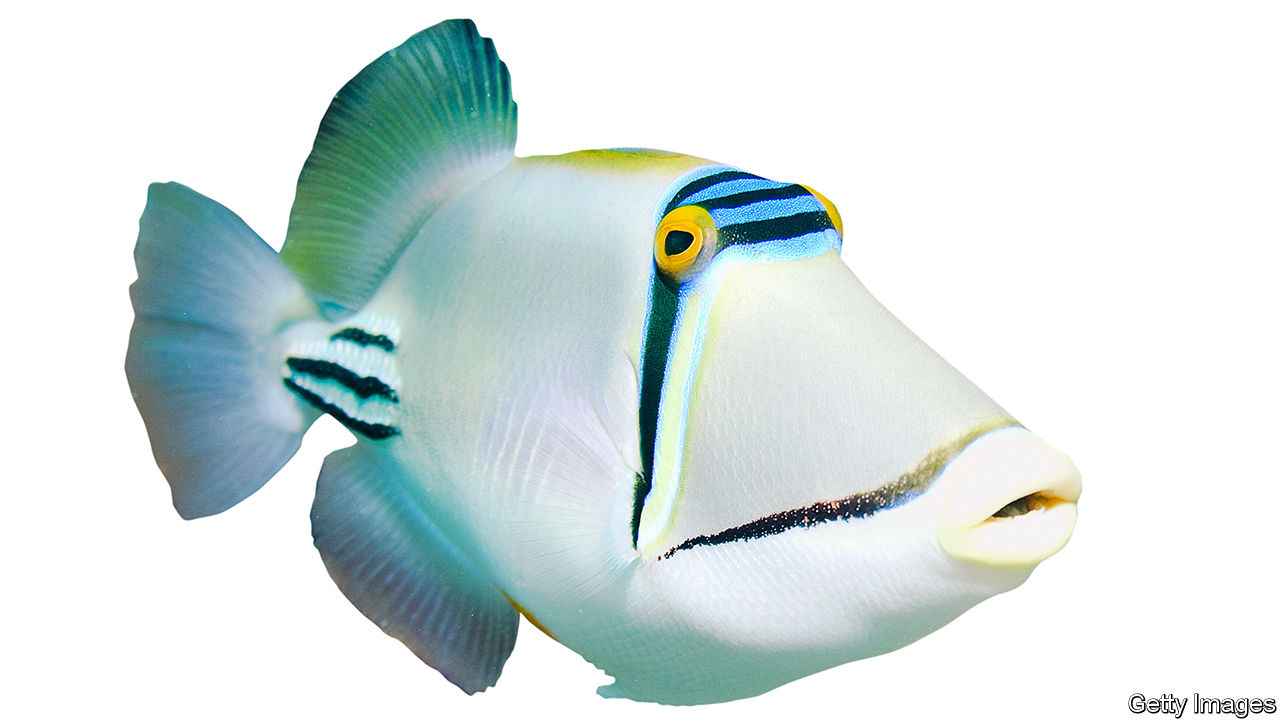
Eye of the Shoal: A Fishwatcher’s Guide to Life, the Ocean and Everything. By Helen Scales. Bloomsbury Sigma; 320 pages; $27.00 and £16.99.
THOSE who lack gills typically meet members of the ichthyic kingdom à la meunière or packed in oil. “So much of the brilliance of fish goes unseen and unknown,” says Helen Scales, a serendipitously named marine biologist. “They live hidden beneath the waves.” In “Eye of the Shoal”, Ms Scales, whose previous book, “Spirals in Time”, explored the world of seashells, brings readers nose to snout with fish in situ.
This, after all, is mostly their world. Water covers 70% of the planet. Fish, the most abundant and diverse of the vertebrates—there are 30,000 species—are one of the great evolutionary success stories. Some can withstand sub-zero polar waters (a natural anti-freeze in the blood of Arctic cod enables them to survive) or a 34°C pool in California’s Death Valley (home to the Devils Hole Pupfish). The Walking Catfish, faced with a shrinking pond, uses its front fins to amble over to safer waters. Torpedo-shaped tuna have retractable pectoral fins to lessen drag. Weaverfish, lionfish and stonefish deploy venomous spines to avoid becoming another fish’s dinner.
Colours provide camouflage—a Warty Frogfish adjusts its hue to blend into the background—or to signal a sex (flamboyance is typically a male attribute). There are deep-sea fish that flash, glow and shimmer to communicate, lure prey or illuminate their way. Most magical of all aquatic habitats is the coral reef, home to galaxies of fish in marzipan tones like the Lemonpeel Angelfish, or stunning patterns like the Picasso Triggerfish (pictured).
Alas, reefs are perishable, vulnerable to ocean acidification, overfishing and global warming, which provoke a chain of events that bleaches coral dead white. A World Wildlife Fund report predicts that, if not checked, global warming will lead reefs to disappear by 2050. Meanwhile, the United Nations Food and Agriculture Organisation estimates that nearly a third of commercial stocks are overfished. Ms Scales might have devoted more than a few pages of her engaging and informative bouillabaisse to these perils.
Do fish have feelings? Can they think? As evidence that they can, Ms Scales cites examples of cognition and tool use. Tusk fish open clams by smashing them against rocks; sharks have been taught to press a target for a reward of food. They seem to be able to feel pain, too. Farmed salmon exhibit symptoms of depression. The temperature of Zebrafish rises when they are confined in a small net.
Empathy for the plight of fish might not be so far-fetched. Consider Tiktaalik, one of the transitional species that made the long, slow leap from water to land some 375m years ago. Humans’ so-called “inner fish”—in the words of Neil Shubin, a palaeontologist at the University of Chicago and part of the team that discovered Tiktaalik in 2004—is reflected in the fossil’s finned lobes, which feature a bone structure analogous to human limbs. “Man still bears in his bodily frame the indelible stamp of his lowly origin,” Darwin wrote in “The Descent of Man”. People, in other words, may simply be fish out of water.
https://www.economist.com/news/books-and-arts/21741955-helen-scaless-new-book-brings-readers-nose-snout-them-secret-life-fishBagikan Berita Ini














0 Response to "A salmon's lamentThe secret life of fish"
Post a Comment